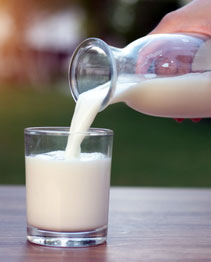Dietary Information about Milk and its Fat Content
 |
Do milk packets like Nandini and others contain fat or not? How frequently is it advisable to consume paneer for a 20-year-old boy?
Most milk packets contain fat. Nandini however has two types; the Orange packet is whole milk, which contains the whole normal fat that is present in cow’s milk (6%). The blue packet is toned milk which contains 3% fat. They also have a yellow packet which is double toned milk, containing 1.5% fat. Some companies supply skimmed milk, which contains less than 1% fat. Normally it is advisable to use the 3% fat milk but after removing as much fat as possible by the following method called ‘skimming’. Heat milk on fire and bring to boil, stirring continuously. After this you must stirring but do not switch off the fire but lower the flame and allow the milk to simmer on slow fire for 10 minutes. Cool, refrigerate and remove the cream after 5-6 hours. Use yesterday’s milk for this morning’s coffee. All those on a weight reduction diet and those who have cholesterol, triglyceride or diabetic problems must use milk that has been skimmed as mentioned above.
However, during weight reduction and till cholesterol and sugar levels are brought down, the ideal thing would be to use skimmed milk powder like Nandini skimmed milk powder or the tetra pack skimmed milk which is approximately 0.5% fat. Some of the popular brands available are Nandini Slim, Amul Slim and Trim and Nestle Slim. To use skimmed milk powder mix 2 heaped or full tablespoons of powder in 1 glass (200 ml) of warm water. Curd made from this is very enjoyable and so is buttermilk and it is safe for consumption whenever hungry. While on a diet 2-3 glasses of this milk is permitted for most people. Paneer bought from a store is usually made from whole milk and therefore quite high in its fat content. I would say consuming this for a young man should be limited to twice a week.
Many young people today, starting from teenagers have given up milk consumption saying it is fattening and some say it is meant only for babies and small children. This could be one of the leading causes of osteoporosis and rising dental problems as well as neck, spine and joint problems. I believe that everybody from birth to death requires at least 2-3 glasses of milk/curd (500ml) daily after the cream has been thoroughly removed or skimmed. The cream is fattening not the milk.
Milk in the diet is the biggest source of calcium supply to the body. We require about 500mg calcium per day and this is available in 500ml of milk/curd which we can consume on a daily basis.
|